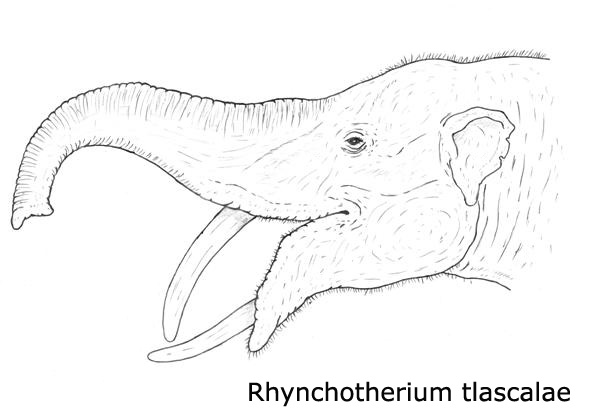Chilgatherium
Chilgatherium is an extinct genus of the order Proboscidea ( Proboscidea ). You will be provided within the mammoths to the family of Deinotheriidae, which is a very original group of the early members of this mammalian order. Chilgatherium is known only through dental remains from Ethiopia, which represent the earliest evidence of this family. The only recognized species is Chilgatherium harrisi.
Features
Chilgatherium has been only about a dozen known tooth findings, both belonging to the upper and the lower jaw. They include the rear premolars (P3 and 4) and the molar ( M1- 3). The back molars was recorded above an oval shape on a maximum of 6 cm length. The occlusal surface was characterized by transverse standing and clearly towering enamel strips, but they were increased at the respective ends by additional bump again ( bunolophodont ). Each of the three molars had three of these bars ( trilophodont ), but the third or rearward formed was less. This makes the teeth differed from those of Deinotherium whose strips were pronounced, so lophodont strictly clearly and without additional melting hump. In addition Deinotherium pointed to the last two molars (M2 and 3) only two bars on ( bilophodont ), only the first (M1 ) was trilophodont. The premolars of Chilgatherium were significantly smaller than the molars and had on the Kauoberfläche rather hunchbacked tooth enamel cusps, the one bunodonten tooth character gave them than Deinotherium.
System
Chilgatherium is considered a genus of the extinct family of Deinotheriidae and is related to the younger and more modern Deinotherium, one of the largest known representative of the mammoths, which lived from the Miocene to the early Pleistocene. The deviating from Deinotherium design of the molars at Chilgatherium suggesting an origin of Deinotherien at proboscidean with more bunolophodonter posterior dentition and three enamel strips. However, a majority of eligible early mammoths, as Barytherium or Numidotherium also reported significantly lophodontere molars with only two bars. A possible candidate would be Arcanotherium from Libya, which is known only by a few fragments of teeth, but bunolophodonte teeth possessed and exhibited on the front and two molars on the last three bars. The previous evolutionary models of mammoths can not satisfactorily explain a secondary reduction of the third bar at Deinotherium. If Arcanotherium be to ask in the ancestral line of Chilgatherium, an exclusion from the family of Deinotherien would probably be in the current situation.
From the perspective of biological systematics, the exact position of the family of Deinotherien was always difficult within the order of Proboscidea. As with the phylogenetically younger Deinotherium is to assume that all teeth had Chilgatherium in use at the same time (vertical change of teeth ). This is in marked contrast to the modern proboscidean with its horizontal change of teeth and provides the animal with a trunk representatives clearly in the first phase of this radiation mammalian order. These earliest mammoths are generally in the primeval Plesielephantiformes, characterized by front molars with two enamel strips, and divided the advanced Elephantiformes with three bars. Because of the second molar with two strips at Deinotherium this is frequently asked to Plesielephantiformes, but since this may be a derived and not an original feature (the first molar has three bars ), some researchers advocate a position within the modern Elephantiformes. The findings of Chilgatherium could support an allocation of Deinotheriidae to Elephantiformes, a more precise classification has thus far remained out.
The first scientific description of Chilgatherium was made in 2004 by William J. Sanders and colleagues research based on finds from Chilga in Ethiopia. As holotype applies a row of teeth of the three right and two left rear molar ( copy number CH35 -3a -e), which is preserved in the Ethiopian National Museum in Addis Ababa. Due to the differences in Zahnbau Chilgatherium their own subfamily Chilgatheriinae was assigned within the Deinotheriidae. So far with Chilgatherium harrisi a kind known. The genus name refers to Chilgatherium Chilga as a reference, while the Greek word θηρίον ( Therion ) " animal " means. The species name honors John M. Harris harrisi for his extensive research on the Deinotherien.
Discovery history
Finds from Chilgatherium were discovered in the region in Gahartal Chilga in northwestern Ethiopia, a plateau-like landscape, which rises to a height of 1950 m above sea level. In numerous outcrops along river valleys that comprise at least 70 points Fund and locally up to 130 m reach thickness, the fund 's leading geological deposits are exposed, composed of volcanic clasts, coal and clay and siltstones. Radiometric dating of orthoclase minerals from these fossil-bearing strata gave an age of 27.4 million years ago, the base region under the Fund layers is 32.4 million years old, according to similar studies. Both results date to the Oligocene. The findings of Chilgatherium that the discovery point Chilga stem 35 so that the oldest remains of Deinotherien, the next most recent are from Kenya and are a bit older than 20 million years. Associated were the fossils with remains of other animals snout, about Phiomia and Palaeomastodon, but also with those of Arsinoitherium and several representatives of the hyrax. The finds were recovered between 1998 and 2003 during scientific field studies.










